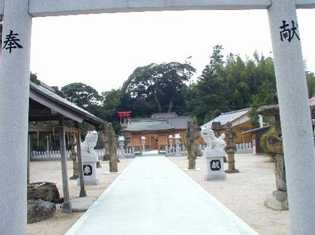八幡様 - Hachiman
In Japan more than 25,000 shrines are dedicated to the god Hachiman. Who was he and why is he so popular? Hachiman has long been known as the God of War, like the god Mars in the western world. Historical records suggest this understanding of Hachiman began in the 7th century.
日本には八幡様を祭った神社が多く、その数は実に2万5千以上です。八幡様とはいったいどんな神様なのでしょう。そして、なぜこれほどまで人々に親しまれているのでしょうか。八幡様は戦いの神様と呼ばれ、西洋の軍神マールスに当ります。記録によると、八幡様のこのような性格付けがなされたのは7世紀に入ってからです。
Hachiman was the favorite god of Minamoto Yoritomo, the founder of the Kamakura Shogunate in 1192. He built the great Hachiman shrine at Kamakura, which still stands today. The true origin of Hachiman is shrouded in mystery, however. As you all know, the early Japanese worshipped all natural and living things. They believed that all things had life and also a Kami (spirit or god).
1192年に鎌倉幕府を開いた源頼朝は、八幡様をたいへん崇拝しており、鎌倉に壮麗な八幡宮を建てました。これは現在でも残っています。八幡様の本当の起源は謎に包まれたままですが、ご存じのように、古代この国の人々は、すべての自然物には魂があり神が宿っていると信じ崇拝してきました。
The story is this: One day long ago, some fishermen on Kyushu found a strange object washed up on shore. It had obviously come from a foreign land, and they began to worship it and pray to it for safe voyages upon the sea. They believed that since the object had survived a long trip in safety, it must be some sort of god. Many ancient shrines dedicated to “Safety at Sea” suggest the Oceanic origins of races contributing bloodlines, character, and legends to today’s Japanese people.
こんな話が残っています。昔、九州のある地方で漁師たちが浜辺に打ち上げられた不思議な物を見つけました。それは明らかに異国から流れ着いたもので、人々は、はるかかなたから日本までやってくるとはただものではないと考え、それを海の守り神として祭り、漁の無事を祈りました。海での安全を祈願するため古くから多くの神社が建てられたことは、日本人の今日の血統、民族性、伝説につながる海洋民族としての起源を物語っています。
Hachiman, as they called it, became popular among fishermen all along the coast, so the oldest Hachiman shrines are on the seacoasts of Japan. Later, people using those shrines wanted something more definite to worship. They decided to use the child emperor, Antoku (1180 – 1185), and he became the deity of the shrines. Finally, however, the shrines were dedicated to the Emperor Ojin (270 A.D. – 312 A.D.). He had added 23 conquered provinces to his empire, so he is considered to be the God of War, and the Hachiman shrines today are all dedicated to him.
八幡様と名付けられたその不思議な物体は、漁師たちの信仰の対象となりました。日本で最も古い八幡宮は海のそばに建っています。やがて、人々はより明確な崇拝の対象を求めるようになりました。そこで、最初は幼少の安徳天皇(1180〜1185)が祭られましたが、やがて応神天皇(270〜312)が八幡宮の神とされるようになりました。応神天皇は23の国を併合したことから戦いの神様と呼ばれ、現存するすべての八幡宮に祭られています。
In this legend, Hachiman means, “8-banners,” which were said to have appeared in the sky at Ojin’s birth. It is said that every Hachiman shrine includes a small side deity. This is usually Takenouchi no Sukune, who was the permanent guest of the Empress Jingu (c. 200 – 270?), Ojin’s mother. Takenouchi no Sukune was famous for directing the war against Korea (3rd century), and represents the perfect loyal servant.
八幡とは八つののぼりを意味し、応神天皇が誕生された日に掲げられたという言い伝えがあります。八幡宮には、通常、応神天皇のほかに、応神天皇の母君神宮皇后(200〜270?)の臣下だったタケノウチノスクネも祭ってあります。彼は、3世紀に起きた朝鮮との戦いを指揮し、天皇に忠孝を尽くしたことで知られています。
Another historical source indicates each Hachiman shrine usually has 2 sub-shrines. One is for the Empress Jingu and the other to Ojin’s wife. Hachiman probably originated in Yahata, Kyushu, because of the black current, which almost certainly carried the original object of worship to Japan hundreds of years ago.
八幡宮の中にはさらに二つの小さな宮があり、一つには神宮皇后、もう一つには応神天皇の妃が祭られています。 日本に流れ着き、漁師たちの信仰の対象となった物体が黒潮に乗ってやってきたことはほぼ間違いありません。このことから、八幡様の起源はおそらく現在の福岡県の八幡にあると思われます。
